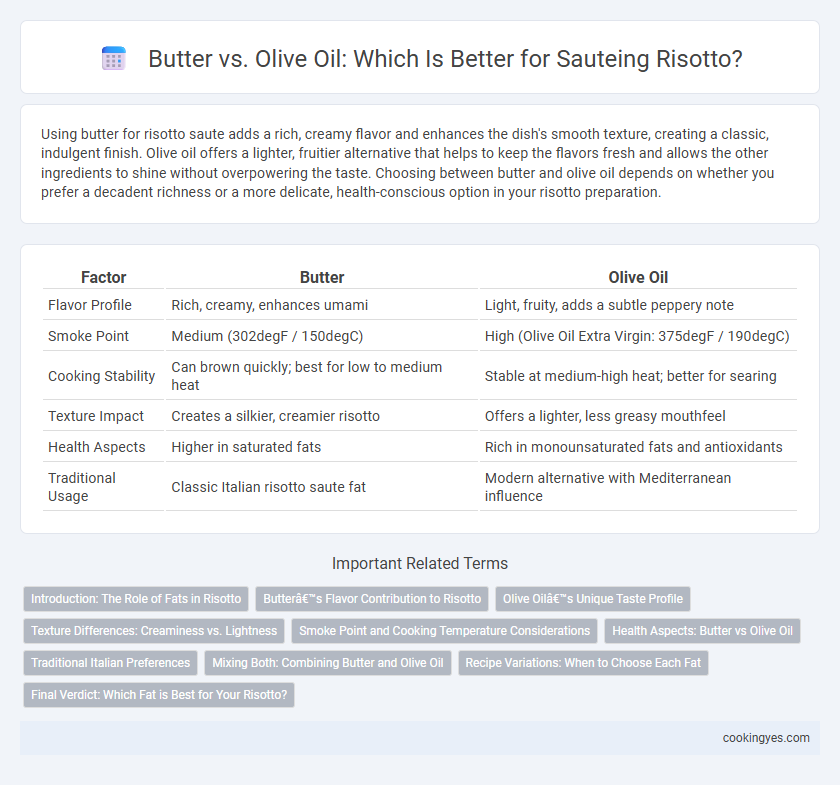Using butter for risotto saute adds a rich, creamy flavor and enhances the dish's smooth texture, creating a classic, indulgent finish. Olive oil offers a lighter, fruitier alternative that helps to keep the flavors fresh and allows the other ingredients to shine without overpowering the taste. Choosing between butter and olive oil depends on whether you prefer a decadent richness or a more delicate, health-conscious option in your risotto preparation.
Table of Comparison
| Factor | Butter | Olive Oil |
|---|---|---|
| Flavor Profile | Rich, creamy, enhances umami | Light, fruity, adds a subtle peppery note |
| Smoke Point | Medium (302degF / 150degC) | High (Olive Oil Extra Virgin: 375degF / 190degC) |
| Cooking Stability | Can brown quickly; best for low to medium heat | Stable at medium-high heat; better for searing |
| Texture Impact | Creates a silkier, creamier risotto | Offers a lighter, less greasy mouthfeel |
| Health Aspects | Higher in saturated fats | Rich in monounsaturated fats and antioxidants |
| Traditional Usage | Classic Italian risotto saute fat | Modern alternative with Mediterranean influence |
Introduction: The Role of Fats in Risotto
Butter and olive oil are essential fats used in the sauteing process of risotto, each influencing flavor and texture distinctly. Butter provides a rich, creamy taste and helps achieve a silky consistency by emulsifying the starch released during cooking. Olive oil offers a lighter, fruitier essence and higher smoke point, making it ideal for controlling heat without burning the rice.
Butter’s Flavor Contribution to Risotto
Butter contributes a rich, creamy flavor and silky texture during the risotto saute, enhancing the dish's depth and mouthfeel. Its milk solids caramelize slightly, adding a subtle nutty aroma that complements the arborio rice's starchiness. Compared to olive oil, butter imbues a more indulgent taste, making the risotto's finish smoother and more luxurious.
Olive Oil’s Unique Taste Profile
Olive oil imparts a rich, fruity aroma with subtle peppery and grassy notes, enhancing the complexity of risotto's flavor profile during sauteing. Its unique taste complements the creamy texture of Arborio rice without overpowering the delicate ingredients like mushrooms or seafood. Using olive oil in risotto saute creates a balanced, Mediterranean-inspired dish characterized by a vibrant and fresh finish.
Texture Differences: Creaminess vs. Lightness
Using butter for risotto saute enhances the dish with a rich, creamy texture due to its milk fat content, contributing to a smooth and velvety mouthfeel. Olive oil, especially extra virgin, provides a lighter, slightly fruity texture that allows individual grains to remain distinct and less oily. Choosing butter results in a more indulgent risotto, while olive oil yields a fresher, lighter consistency that highlights the rice's natural firmness.
Smoke Point and Cooking Temperature Considerations
Butter, with a smoke point around 350degF (175degC), imparts a rich, creamy flavor to risotto but requires careful temperature control to avoid burning during the saute process. Olive oil, especially extra virgin varieties with a smoke point between 375degF and 410degF (190degC to 210degC), offers a higher cooking temperature tolerance, making it more suitable for prolonged sauteing without smoking. Balancing the use of butter and olive oil can optimize flavor while maintaining appropriate heat management in risotto preparation.
Health Aspects: Butter vs Olive Oil
Olive oil contains heart-healthy monounsaturated fats and antioxidants, which support cardiovascular health and reduce inflammation. Butter, rich in saturated fats and cholesterol, can raise LDL cholesterol levels when consumed excessively, potentially increasing heart disease risk. Choosing olive oil for risotto saute enhances the dish with beneficial nutrients while minimizing adverse effects on cholesterol and heart health.
Traditional Italian Preferences
Traditional Italian risotto recipes typically prefer butter for sauteing ingredients due to its rich flavor and creamy texture that enhances the dish's overall taste. Olive oil is sometimes used, especially in northern regions, but butter remains the classic choice for creating the signature velvety consistency of authentic risotto. Using butter in the initial saute step helps develop a deep, nuanced flavor that aligns with Italy's culinary heritage.
Mixing Both: Combining Butter and Olive Oil
Combining butter and olive oil for risotto saute enhances flavor complexity and improves texture by balancing butter's richness with olive oil's higher smoke point. This mixture prevents butter from burning during the cooking process while infusing the rice with a creamy, silky mouthfeel essential for authentic risotto. Using both fats together ensures a perfectly sauteed base that maximizes taste and maintains ideal consistency throughout the dish.
Recipe Variations: When to Choose Each Fat
Butter enhances risotto saute by providing a rich, creamy texture and a slightly nutty aroma, ideal for classic Italian recipes or when finishing the dish with parmesan cheese. Olive oil offers a lighter, fruitier flavor and higher smoke point, making it suitable for versions with Mediterranean ingredients like tomatoes, seafood, or herbs. Choosing between butter and olive oil depends on the desired flavor profile and cooking technique, with butter best for indulgence and olive oil preferred for health-conscious or robustly flavored risottos.
Final Verdict: Which Fat is Best for Your Risotto?
Butter imparts a rich, creamy flavor and helps create a luxurious texture essential for classic risotto, while olive oil offers a lighter, fruitier taste with a higher smoke point for better sauteing control. Combining butter and olive oil can balance creaminess and cooking precision, enhancing both flavor and consistency. The best fat depends on personal preference and desired flavor profile; chefs often favor butter for traditional risotto but incorporate olive oil for a modern twist or health-conscious variation.
Butter vs Olive Oil for Risotto Sauté Infographic

 cookingyes.com
cookingyes.com